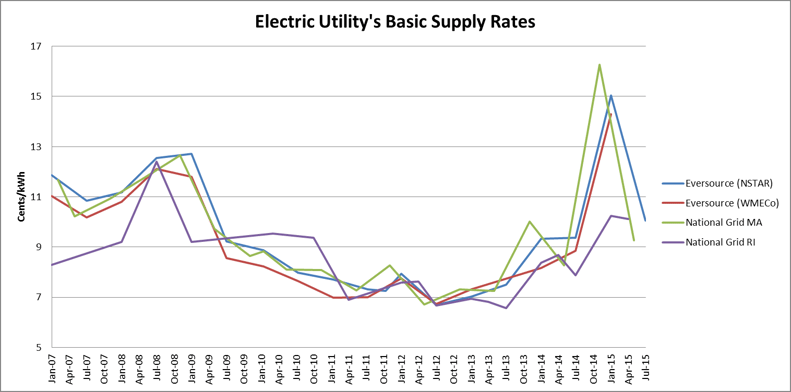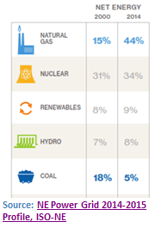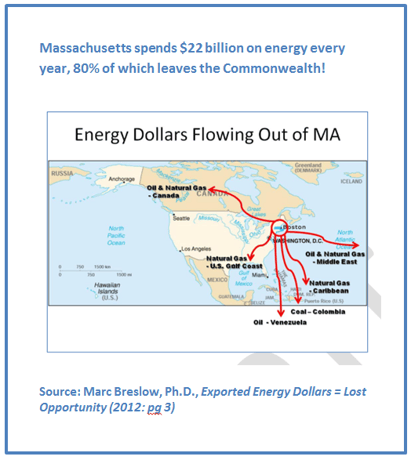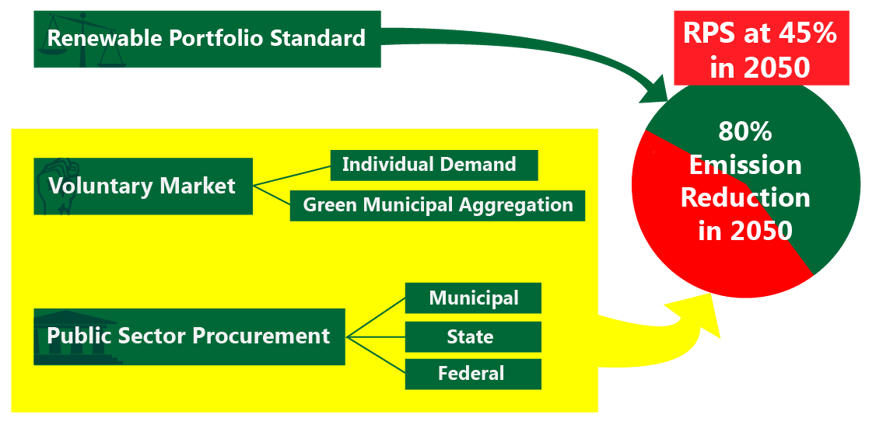Communities are demanding more renewable energy—and they're getting it.
We take great pride in the fact that we, along with a company called Good Energy, took the model of municipal...
andPriscilla De La Cruz and Katy Kidwell
andPriscilla De La Cruz and Katy Kidwell
Consumers have been on an electric rates rollercoaster ride this past year. Many have been left reeling from a freezing winter and higher-than-usual electric rates. The good news is that rates will be dropping back down this summer for utility basic supply customers. National Grid’s rate decreased more than 40% as of May 1st (for MA customers). Eversource customers will likely experience similar decreases beginning July 1st. These summer rate drops will provide much needed relief, but what needs to be done to ensure this does not continue to happen in winters to come?

Source: Mass. Dept. of Energy Resources and the RI Public Utilities Commission
Electric distribution companies (e.g., National Grid and Eversource) provide Massachusetts and Rhode Island electric customers with a default electric supply product. They regularly adjust the price of this supply by developing a market rate based on current electricity prices and availability. This rate is submitted to the Department of Public Utilities for approval to ensure that customers are billed a fair default price. In MA, utilities change their basic supply rate twice a year: in May and November for National Grid customers and in July and January for Eversource customers. In RI, National Grid is the only electric distribution company. They change their rates three times per year in April, July, and January.
Since the utility’s basic supply service is a default, there are other supply options out there. Most residential consumers use the utility’s regulated supply rate, but a customer can choose a competitive electric supplier with a different rate. Competitive suppliers are not subject to DPU regulation; they set and change their rates at their discretion. Mass Energy and People’s Power and Light generally do not recommend these suppliers because their unregulated rates can fluctuate unexpectedly and involve contracts with high termination fees.
 Why the Recent Hikes?
Why the Recent Hikes?When last winter’s utility rate changes took effect, MA customers saw their supply rates nearly double. A similar though less drastic increase was experienced by RI customers. This is because New Englanders have become overly dependent on natural gas to generate electricity, and in the winter, we rely on it to heat our homes. In the past 15 years New England has made a significant shift away from coal and oil to natural gas to generate electricity, in part because natural gas is cheaper and less carbon intensive than coal and oil. Today natural gas makes up nearly half of the region’s electricity resource mix. During periods of peak demand such as a very cold winter’s night from 4-8 p.m. when lights are on in homes and businesses, the market price of natural gas-fired electricity skyrockets. An economy based on natural gas is going to face volatile energy prices.
This summer’s utility supply rates will decrease relative to last winter. National Grid’s rates decreased from 16.273 cents/kwh to 9.257 cents/kWh on May 1st for MA customers (RI customers have stayed at about 10 cents/kWh since January). Similarly, Eversource has released a proposed rate decrease from 14.288 cents/kWh to 10.05 on July 1st.[1] This is great news for electric consumers across the Commonwealth who will soon pay lower electric bills!
But what about next winter’s rate cycle… What needs to be done to get electricity prices under control once and for all?
The position taken by the utilities (who have a vested interest in building new pipelines and transmission lines) is, “We just need more pipeline capacity!” The Baker Administration seems to agree. The problem with this short-sighted approach is threefold.
First, additional pipelines take time to build. At the earliest, we wouldn’t see new capacity come online for 3 more years. Which means rate stability would not be achieved in the near term simply by committing to more natural gas.
 Second, and more to the point, while increased pipeline capacity could alleviate rate hikes initially, it is unlikely that natural gas will remain the cheap or plentiful resource that it is perceived to be today. Additionally, for a region with urgent climate change mitigation goals (80% carbon emission reductions by 2050 per the Global Warming Solutions Act), facilitating an over-reliance on fossil fuels is counter-intuitive.
Second, and more to the point, while increased pipeline capacity could alleviate rate hikes initially, it is unlikely that natural gas will remain the cheap or plentiful resource that it is perceived to be today. Additionally, for a region with urgent climate change mitigation goals (80% carbon emission reductions by 2050 per the Global Warming Solutions Act), facilitating an over-reliance on fossil fuels is counter-intuitive.
Third, who is going to pay the tab if there are huge cost overruns on the pipeline construction?
The long-term solution to avert future rate hikes requires improving existing pipelines, expanding our energy efficiency efforts, and diversifying the region’s electric resource mix with renewables.
Massachusetts and Rhode Island have among the oldest and leakiest natural gas distribution infrastructure in the country. Gas leaks from aging infrastructure waste the natural gas we are able to get into the region, and the methane emissions associated with leaking gas are more potent than carbon dioxide. Repairing these pipelines along with expanding the region’s energy efficiency initiative will make the energy that we can get go even farther.
After addressing leaks and efficiency, we should turn to the electric resource mix itself. Should natural gas really fuel half of our electric needs? Diversifying our power grid with wind, solar, digester gas and hydro generation will alleviate our overdependence on natural gas. New England states should aggressively incentivize renewable energy generation via legislation to expand renewable energy standards.
We can also affect the situation at the local level. Cities and towns can lead by example through green municipal aggregation. Using aggregation, a municipality can take their energy supply into their own hands. This is a good way for consumers to get the benefits of a competitive marketplace without being thrown to the wolves. In this model, the municipality works with a competitive supplier to create a supply product unique to the town. Since it is a large contract, the municipality can negotiate a fair and stable price (lasting 1-3 years) for the town. Inaddition, an aggregated supply product can include a higher renewable content than what is mandated by the state. Melrose is currently developing an aggregation plan that will include a default supply product with 5% more renewable energy than the rest of the state.
Finally, concerned individuals can vote with their dollar and switch to 100% New England renewables for their electricity through programs like New England GreenStart or New England Wind. All of these strategies will lighten the power grid’s need for natural gas, stabilizing our supply rates with the added benefit of reducing emissions along the way.
Voluntary demand and procurement of renewables in addition to policy is necessary to meet our climate goals:

[1] Pending the DPU’s approval.
We take great pride in the fact that we, along with a company called Good Energy, took the model of municipal...
andPriscilla De La Cruz and Katy Kidwell
In Massachusetts, customers of Eversource, National Grid, and Unitil receive electricity bills that are split into...
andPriscilla De La Cruz and Katy Kidwell
Comments